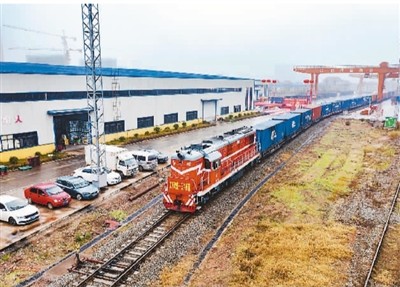China secures extraordinary achievements in expanding high-level opening up in 2021
China made extraordinary achievements in pushing high-level opening up in 2021 against the backdrop of profound changes and a pandemic unseen in a century. The country opened even wider to the rest of the world, creating opportunities for its own development and injecting strong momentum into the steady recovery of the global economy.

Photo shows an interior view of the Greenland Global Commodity Trading Hub, a permanent trading platform for the China International Import Expo (CIIE). The hub is next to CIIE’s venue – the National Exhibition and Convention Center (Shanghai) in Shanghai. (Xinhua/Fang Zhe)
On Dec. 27, 2021, China unveiled its latest national negative list and pilot free trade zone (FTZ) negative list for foreign investment, as part of efforts to further open up the economy. This marked the fifth consecutive year that China has revised the two negative lists.
The number of items that are off-limits for foreign investors will be cut to 31 for the nationwide version, and 27 for the pilot FTZ version, with a reduction ratio of 6.1 percent and 10 percent, respectively, according to a statement jointly released by the National Development and Reform Commission and the Ministry of Commerce. In 2017, there were 93 and 122 items on the lists, respectively.
China’s continued expansion of the scope for foreign investment has created a broader space for foreign investors. Bucking a sharp drop in global cross-border investment, China attracted $149.34 billion of foreign direct investment (FDI) in 2020, maintaining its status as the world’s second biggest recipient of FDI. In the first 11 months of 2021, FDI into the Chinese mainland, in terms of actual use, topped the 1-trillion-yuan ($156.85 billion) mark, surpassing the overall annual FDI achieved in 2020.
Last year marked the 20th anniversary of China’s accession to the World Trade Organization. Over the past two decades, China has fully delivered on its accession commitments. Its overall tariff rate had been cut from 15.3 percent to 7.4 percent, lower than the 9.8 percent accession commitment. On Dec. 15, 2021, the Customs Tariff Commission of China’s State Council announced that the country would eliminate tariffs on a radium chloride injection, a new anticancer drug, and reduce tariffs on some imported commodities, including aquatic products, baby clothing, and ski gear, in 2022.
A large batch of high-standard projects under the Belt and Road Initiative (BRI) witnessed new progress in 2021.

People shop at the Haikou Riyue Plaza duty-free shop in south China’s Hainan province, Nov. 23, 2020. (Xinhua/Guo Cheng)
The China-Laos Railway, a landmark project of high-quality Belt and Road cooperation, started operation on Dec. 3, 2021. The railway, which connects Kunming in southwest China’s Yunnan Province with the Lao capital Vientiane, can reduce transport costs between the two cities by 40-50 percent, according to a report released by the World Bank. The transit trade through Laos along the railway is expected to reach 3.9 million tonnes per year by 2030.
Under the BRI framework, over 90 percent of the total civil construction works for the Jakarta-Bandung high-speed railway in Indonesia were completed and the cornerstone was laid for the Hungarian section of the Budapest-Belgrade railway connecting the capital cities of Hungary and Serbia, while the construction of the railway’s section running from Novi Sad to Subotica in Serbia has been initiated.
In 2021, China-Europe freight train trips continued to see steady growth. In November 2021 alone, the number of China-Europe freight train trips rose 1 percent year-on-year to reach 1,246, exceeding 1,000 for the 19th consecutive month, and with the freight trains carrying 120,000 twenty-foot equivalent units (TEUs) of cargo, up 4 percent from a year earlier. As of the end of November 2021, China-Europe freight trains had made 47,414 trips and transported 4.3 million TEUs of goods.
China’s “circle of friends” under the BRI has continued to expand. As of Dec. 15 last year, China had signed more than 200 cooperation documents for the joint construction of the Belt and Road with 145 countries and 32 international organizations.
The fourth China International Import Expo (CIIE) kicked off in Shanghai on Nov. 5, 2021. At the event, over 420 new products, technologies and services were showcased. Nearly 3,000 companies from 127 countries and regions participated in the event. The numbers of enterprises as well as countries and regions that had been attracted to the event both surpassed those of the third CIIE. A total of $70.72 billion worth of tentative deals were reached at the fourth CIIE, increasing from $57.83 billion during the first CIIE.
The fourth Hongqiao International Economic Forum was also held simultaneously with the expo. Over 2,000 guests at 12 sub-forums and an international seminar of the forum exchanged ideas on hot topics, including green development and the digital economy, and explored paths towards building a community with a shared future for mankind. The World Openness Report 2021 was issued at the forum, calling for greater international cooperation to promote opening up.

A China-Europe freight train departs from Dongxiang district, Fuzhou city, east China’s Jiangxi Province, on Dec. 16, 2021, heading for the city of Vorsino in Russia. (People’s Daily Online/Rao Fangqi)
The first China International Consumer Products Expo (CICPE) concluded on May 10, 2021, at the Hainan International Convention and Exhibition Center in Haikou, capital of south China’s Hainan Province. It was the first ever expo focusing on high-quality consumer goods that has been held by China at the national level. A total of 70 countries and regions attended the four-day expo, and 2,628 brands of 1,505 enterprises from home and abroad participated in the exhibitions.
The CICPE, along with the CIIE in Shanghai, the Canton Fair in south China’s Guangdong Province, and the China International Fair for Trade in Services in Beijing, has become yet another global public good for the world to share in China’s own development opportunities.
Last year, China made steady progress in reform and innovation for its pilot FTZs. In early September 2021, China rolled out a raft of new measures on promoting reform and innovation for trade and investment facilitation at its pilot FTZs, including helping them develop offshore trade capabilities.
Wang Shouwen, Vice Minister of Commerce, said the 19 new measures focusing on advancing investment and trade facilitation gave the pilot FTZs greater command over reform, enabling them to better leverage their roles as pioneers and as good examples of reform and opening up.
Wang Wentao, Minister of Commerce, said that China would introduce a negative list for cross-border services trade in the pilot FTZs as soon as possible and support some pilot FTZs and free trade ports to learn and adopt the rules of high-level international free trade agreements.
Photos
Related Stories
- China steps up efforts to accelerate reform, opening-up
- Chinese premier stresses effective macro policies, further opening-up
- Experts speak highly of China's opening up wider to world
- China's opening-up experience useful for world: report
- Opening wider to world
- China committed to expanding opening-up, facilitating free trade: premier
Copyright © 2022 People's Daily Online. All Rights Reserved.










